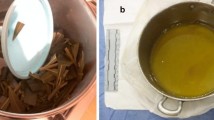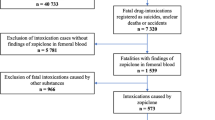Abstract
Acetaldehyde is a strongly electrophilic compound that is endogenously produced as a first intermediate in oxidative ethanol metabolism. Its high reactivity towards biogenic nucleophiles has toxicity as a consequence. Acetaldehyde readily undergoes a non-enzymatic condensation reaction and consecutive ring formation with cysteine to form 2-methylthiazolidine-4-carboxylic acid (MTCA). For analytical purposes, N-acetylation of MTCA was required for stabilization and to enable its quantification by reversed-phase chromatography combined with electrospray ionization–tandem mass spectrometry. Qualitative screening of post mortem blood samples with negative blood alcohol concentration (BAC) mostly showed low basal levels of MTCA. In BAC-positive post mortem samples, but not in corresponding urine specimens, strongly increased levels were present. To estimate the association between ethanol consumption and the occurrence of MTCA in human blood, the time curves of BAC and MTCA concentration were determined after a single oral dose of 0.5 g ethanol per kilogram of body weight. The blood elimination kinetics of MTCA was slower than that of ethanol. The peak concentration of MTCA (12.6 mg L-1) was observed 4 h after ethanol intake (BAC 0.07‰) and MTCA was still detectable after 13 h. Although intermediary acetaldehyde scavenging by formation of MTCA is interesting from a toxicological point of view, lack of hydrolytic stability under physiological conditions may hamper the use of MTCA as a quantitative marker of acetaldehyde exposure, such as resulting from alcohol consumption.








Similar content being viewed by others
References
Comporti M, Signorini C, Leoncini S, Gardi C, Ciccoli L, Giardini A, Vecchio D, Arezzini B (2010) Genes Nutr 5(2):101–109. doi:10.1007/s12263-009-0159-9
Albermann ME, Musshoff F, Doberentz E, Heese P, Banger M, Madea B (2012) Int J Legal Med 126(5)757–764. doi:10.1007/s00414-012-0725-3
Bicker W, Lammerhofer M, Keller T, Schuhmacher R, Krska R, Lindner W (2006) Anal Chem 78(16):5884–5892. doi:10.1021/ac060680+
Politi L, Leone F, Morini L, Polettini A (2007) Anal Biochem 368(1):1–16. doi:10.1016/j.ab.2007.05.003
Vina J, Estrela JM, Guerri C, Romero FJ (1980) Biochem J 188(2):549–552
Huang TC, Huang LZ, Ho CT (1998) J Agric Food Chem 46(1):224–227. doi:10.1021/jf9705633
Serrano E, Pozo Oscar J, Beltran J, Hernandez F, Font L, Miquel M, Aragon Carlos MG (2007) Rapid Commun Mass Spectrom 21(7):1221–1229. doi:10.1002/rcm.2951
Brooks PJ, Theruvathu JA (2005) Alcohol 35(3):187–193. doi:10.1016/j.alcohol.2005.03.009
Park SC, Han JA, Han JG, Kang HS (1995) Korean J Biochem 27(1):41–45
Tsukamoto S, Kanegae T, Nagoya T, Shimamura M, Mieda Y, Nomura M, Hojo K, Okubo H (1990) Arukoru Kenkyu To Yakubutsu Izon 25(5):429–440
Collins MA (1988) Recent Dev Alcohol 6:387–403
Kuschinsky G, Luellmann H (1984) Short textbook of pharmacology and toxicology, 10th edn
Otsuka M, Harada N, Itabashi T, Ohmori S (1999) Alcohol 17(2):119–124. doi:10.1016/S0741-8329(98)00042-1
Quertemont E, Tambour S (2004) Trends Pharmacol Sci 25(3):130–134. doi:10.1016/j.tips.2004.01.001
Yamada Y, Imai T, Ishizaki M, Honda R (2006) J Hum Genet 51(2):104–111. doi:10.1007/s10038-005-0330-0
Vogt BL, Richie JP (2007) Biochem Pharmacol 73(10):1613–1621. doi:10.1016/j.bcp.2007.01.033
Riemschneider R, Hoyer GA (1962) Z Naturforsch 17b:765–768
Kallen RG (1971) J Am Chem Soc 93(23):6236–6248
Nagasawa HT, Goon DJ, Zera RT, Yuzon DL (1982) J Med Chem 25(5):489–491
Pesek JJ, Frost JH (1975) Tetrahedron 31(8):907–913
Fulop F, Mattinen J, Pihlaja K (1990) Tetrahedron 46(18):6545–6552. doi:10.1016/s0040-4020(01)96019-3
Butvin P, Al-Ja’Afreh J, Svetlik J, Havranek E (1999) Chem Pap 53(5):315–322
Sprince H, Parker CM, Smith GG, Gonzales LJ (1974) Agents Actions 4(2):125–130
Weber HU, Fleming JF, Miquel J (1982) Arch Gerontol Geriatr 1(4):299–310
Wlodek L, Rommelspacher H, Susilo R, Radomski J, Hofle G (1993) Biochem Pharmacol 46(11):1917–1928. doi:10.1016/0006-2952(93)90632-7
Juliano C, Cossu M, Rota MT, Satta D, Poggi P, Giunchedi P (2011) Drug Dev Ind Pharm 37(10):1192–1199. doi:10.3109/03639045.2011.563783
Kartal A, Hietala J, Laakso I, Kaihovaara P, Salaspuro V, Sakkinen M, Salaspuro M, Marvola M (2007) J Pharm Pharmacol 59(10):1353–1358. doi:10.1211/jpp.59.10.0004
Salaspuro V, Hietala J, Kaihovaara P, Pihlajarinne L, Marvola M, Salaspuro M (2002) Int J Cancer 97(3):361–364. doi:10.1002/ijc.1620
Salaspuro VJ, Hietala JM, Marvola ML, Salaspuro MP (2006) Cancer Epidemiol Biomarkers Prev 15(1):146–149. doi:10.1158/1055-9965.EPI-05-0248
Anni H, Pristatsky P, Israel Y (2003) Alcohol Clin Exp Res 27(10):1613–1621. doi:10.1097/01.ALC.0000089958.65095.84
Guttormsen AB, Schneede J, Fiskerstrand T, Ueland PM, Refsum HM (1994) J Nutr 124(10):1934–1941
Parodi O, De Chiara B, Baldassarre D, Parolini M, Caruso R, Pustina L, Parodi G, Campolo J, Sedda V, Baudo F, Sirtori C (2007) Clin Biochem 40(3–4):188–193. doi:10.1016/j.clinbiochem.2006.08.017
Yardim-Akaydin S, Ozkan Y, Ozkan E, Torun M, Simsek B (2003) Clin Chim Acta 338(1–2):99–105. doi:10.1016/j.cccn.2003.07.021
Ohata H, Otsuka M, Ohmori S (1997) J Chromatogr B Biomed Sci Appl 693(2):297–305. doi:10.1016/S0378-4347(97)00065-0
Kartal-Hodzic A, Marvola T, Schmitt M, Harju K, Peltoniemi M, Sivén M (2012) Pharm Dev Technol. doi:10.3109/10837450.2012.659253
Author information
Authors and Affiliations
Corresponding authors
Rights and permissions
About this article
Cite this article
Reischl, R.J., Bicker, W., Keller, T. et al. Occurrence of 2-methylthiazolidine-4-carboxylic acid, a condensation product of cysteine and acetaldehyde, in human blood as a consequence of ethanol consumption. Anal Bioanal Chem 404, 1779–1787 (2012). https://doi.org/10.1007/s00216-012-6255-5
Received:
Revised:
Accepted:
Published:
Issue Date:
DOI: https://doi.org/10.1007/s00216-012-6255-5




